2018 BMW F 750 GS and F 850 GS test: which one to choose ?
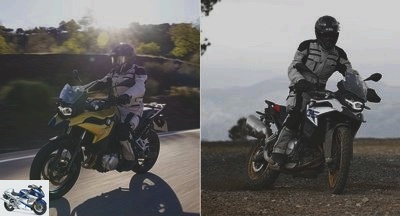
In 2018, the BMW F750GS and F850GS gain in displacement and technology to succeed the F700GS and F800GS launched in 2007. How to choose between these two variations of the trail type, designed from the same engine and chassis platform ? Answer in this double test Site !
F750GS / F850GS test page 3: technical point
Engine
Many changes are made to the in-line twin common to the F750GS and F850GS, starting with an increase in displacement from 798cc to 853cc. This increase obviously benefits the performance which climbs to 77 hp and 83 Nm for the F750GS (+2 hp and +6 Nm compared to 2017) and 95 hp and 92 Nm for the F850SGS (+10 hp and +9 Nm).
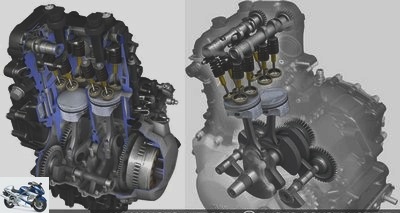
This engine with dimensions of 84 x 77 mm also adopts a new setting at 270 °, against 360 ° previously. Two balance shafts are integrated to control the vibrations of this mechanism made more alive by its change of timing. An assisted clutch with anti-dribble also makes its appearance.
The injection is managed by an electronic accelerator, which allows the use of several engine maps via driving modes (two standard: Rain and Road). Still identical on the two models, the average consumption is down slightly: 4.1 l / 100 km announced instead of 4.3 in 2017.
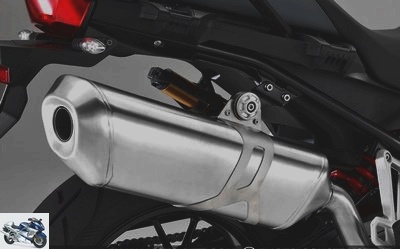
Finally, the final chain transmission now operates on the left side while the stainless steel silencer takes place on the right. This reversal aims – according to BMW – to avoid the risk of burns when traveling when stationary, since the majority of bikers are placed on the left to push their motorcycle. This approach is similar to that followed by the "big sister" R1200GS in 2013.
Note that the F750GS and F850GS are also available in the A2 license format: their engine is in this case limited to 48 hp (35 kW) and 63 Nm of torque. Finally, this engine is "designed and developed in Germany" but assembled "in China", admits BMW. By insisting, the manufacturer ended up specifying that it is Loncin who manufactures this twin in its Chinese factories. It is also with Loncin that BMW manufactures its C400X scooter.
Cycle part
The aluminum trellis frame of the old F700GS and F800GS gives way to a new frame, still of the tubular type but now in steel. BMW justifies this choice by the advantages offered by steel in terms of robustness and ease of repair. Another advantage that the manufacturer "forgets" to mention: a steel frame costs much less to produce. !
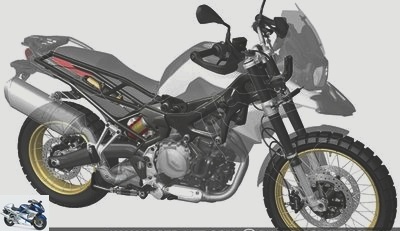
In addition to this change in material, the steel mesh of the F750GS and F850GS has been redesigned to move the fuel tank: until now under the saddle, it now takes place between the rider and the handlebars, like on a classic motorcycle. The engineers evoke in particular a better centralization of the masses to explain this change of technical orientation.
We note in passing that this container loses one liter of capacity (15 liters against 16 in 2017), while the small GS grow by 12 kg each: the F750GS admits 224 kg and the F850GS 229 kg! A weight gain largely linked to the replacement of the aluminum of the chassis by steel. Little consolation: the space under the saddle increases thanks to the displacement of the tank … but not enough to slip a "U" in the trunk. Pity…
Braking is entrusted to dual 305 mm discs at the front, which bite the Brembo two-piston floating calipers. Installed as standard, the ABS can be deactivated and sees its action more or less reinforced depending on the driving mode engaged (very sensitive in rain mode, less active in road mode). As an option, the F750GS and F850GS can be fitted with the "Dynamic" brake light developed by BMW: the rear LEDs flash more or less quickly when braking is applied..
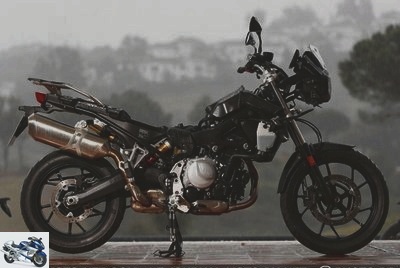
In terms of peripherals, the F750GS retains a 41mm telescopic fork when the F850GS renews its inverted 43mm fork. As in 2017, these elements are not adjustable, unlike the mono-shock absorber installed in a central position, whose preload and rebound are adjustable (ESA electronic damping optional).
The geometry of the two motorcycles has changed significantly, notably the wheelbase (+2 mm on the F750GS and +20 mm on the F850GS) and the hunting angle: the 750 opens by one degree (27 °) and the 850 two degrees (28 °). The saddle height – not adjustable – is revised downwards to improve accessibility, especially on the F850GS which loses 20 mm (850 mm). The F750GS peaks at 815 mm, or +2 mm compared to 2017.
As before, the F850GS is more off-road with its cross spoke aluminum rims which receive tires in 90/90/21 and 150/70/17. Its suspensions frolic in this spirit over a fairly large amplitude, of the order of 204 mm at the front and 219 mm at the rear. However, we note that the fork loses 26 mm of travel compared to 2017 (230 mm at the front and 215 mm at the rear in 2017).
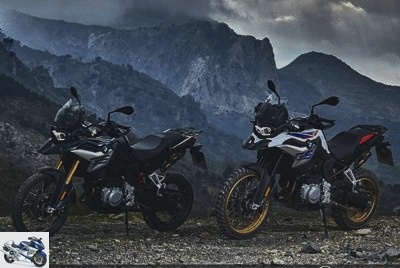
More accessible and more "road", the F750GS receives aluminum rod rims and tires in 110/80/19 and 150/70/17. A wider and less high rise in the front, therefore more obvious on the road but less effective in off-road. Travel is 151 mm at the front and 170 mm at the rear, again significantly less than in 2017: 170 mm at the front and 170 mm at the rear on the previous F700GS.
Finally, note that the arch at the crotch has been reduced and that the "handlebar-saddle-footrest" triangle has been improved, specifies BMW which has endeavored to make its new trails more accessible and comfortable.
Pilot aids, electronics
The F750GS and F850GS receive standard ABS and ASC traction control, the action of which varies according to the driving mode engaged. These are two in number of origin: "Rain" and "Road". The response to acceleration is logically less sharp in "Rain" mode, while the sensitivity of the ABS and traction control is on the contrary higher..

As an option, three additional modes are offered: "Dynamic", "Enduro" and "Enduro Pro". This Enduro Pro mode is only accessible on the F850GS, and automatically deactivates the ABS on the rear to allow skidding on the rear brake. Still as an option, BMW offers more sophisticated traction control and ABS, as it is sensitive to tilt thanks to angle sensors..
The – long – catalog of optional elements of the small "GS" also includes the "e-call" emergency call system, a full LED headlight, the Pro shifter (up and down gears without disengaging), the Keyless (keyless start) but also a 6.5-inch TFT color matrix screen. This instrumentation can also be connected to a telephone, providing access to its Playlist and contacts as well as to the new BMW Connected application. This displays basic navigation elements on the dashboard, such as a GPS.
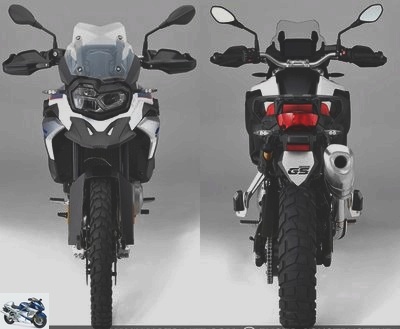
Finally, the ESA electronic damping dear to the German brand is also offered as an option on both motorcycles. As in 2017, this system only intervenes the rear shock absorber by means of an electrically controlled regulating valve. Adjustments to the hydraulic laws of the spring only take "a few thousandths of a second" describes BMW, which ensures that this optional ESA offers "optimal" damping comfort and "particularly stable behavior, even when the bike is lying down in a corner. ".
Related articles
-
Test Triumph Tiger 1200 XRT and XCA 2018: ready for the road adventure Electric window, keyless start, hill start assistant, directional lights,…
-
2018 BMW F 750 GS and F 850 GS test: which one to choose ? In 2018, the BMW F750GS and F850GS gain in displacement and technology to succeed the F700GS…
-
2017 KTM 1090 Adventure review: more is better ! The 1050 Adventure, launched in 2015, became 1090 Adventure two years later, with a power leap of 30 hp….
-
2018 BMW F 750 GS and F 850 GS test: which one to choose ? In 2018, the BMW F750GS and F850GS gain in displacement and technology to succeed the F700GS…
-
Ninja H2 SX test: sporty road bike, in green and against everything ! Kawasaki has no shortage of air: three years after the launch of its Ninja H2 / R,…
-
2017 Suzuki V-Strom 1000 XT test: a super cost ! The Suzuki V-Strom 1000 , relaunched in 2013 after a career suspension in 2008 due to Euro 3 standards,…
-
Roadster – Test Yamaha MT-09 2017: mult (r) iples pleasures! – Page 3 – Technical point MT-09 2017
2017 Yamaha MT-09 review: mult (r) iples pleasures ! Having become a bestseller in just four years, the Yamaha MT-09 is full of positive developments for…
-
Roadster – Test Honda CB1000R 2018: change of universe – Test CB1000R 2018 – Page 3: Technical point
2018 Honda CB1000R Test: Change of Universe Ten after making headlines, the Honda CB 1000 R is looking for a new style. Storing her modern influences in…
-
2018 Triumph Tiger 800 XCA and XRT test: smart vision Does the imposing Triumph Tiger 1200 intimidate you? Opt for the Tiger 800 2018: more accessible…
-
Custom – BMW K1600B test: Power Bagger! – Page 3 – Technical point MNC K1600B
BMW K1600B test: Power Bagger ! The last BMW custom motorcycle, the R1200C discontinued in 2004, did not leave lasting memories … It is different for…